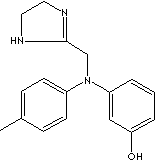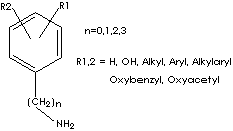| CAS
NO. |
50-60-2
(Base)
73-05-2 (Hydrochloride)
65-28-1 (Mesylate) |

|
| EINECS
NO. |
200-793-5 |
| FORMULA |
C17H19N3O·CH3SO3H |
| MOL
WT. |
377.47 |
|
H.S.
CODE
|
|
|
TOXICITY
|
|
| SYNONYMS |
m-[N-(2-lmidazolin-2-ylmethyl)-p-toluidino] phenol;
|
2-(N-[m-Hydroxyphenyl]-p-toluidinomethyl)imidazoline;
|
|
SMILES |
|
|
CLASSIFICATION
|
|
|
PHYSICAL
AND CHEMICAL PROPERTIES
|
| PHYSICAL
STATE |
white
to off-white crystalline powder |
| MELTING
POINT |
177
- 178 C |
| BOILING
POINT |
|
| SPECIFIC
GRAVITY |
|
| SOLUBILITY
IN WATER |
Soluble |
| pH |
|
| VAPOR
DENSITY |
|
| AUTOIGNITION |
|
| NFPA
RATINGS |
|
|
REFRACTIVE
INDEX
|
|
| FLASH
POINT |
|
| STABILITY |
Stable
under ordinary conditions |
|
APPLICATIONS
|
Phentolamine is an adrenergic receptor antagonist and peripheral
vasodilator. It is used to prevent and treat hypertension due to
pheochromocytomain and to control cutaneous necrosis and sloughing when
extravasation of norepinephrine. It is chemically described as
m-[N-(2-lmidazolin-2-ylmethyl)-p-toluidino] phenol or
2-(N-[m-Hydroxyphenyl]-p- toluidinomethyl) imidazoline.
Phentolamine Hydrochloride: the monohydrochloride salt of phentolamine;
administered orally.
Phentolamine Mesylate: the methanesulfonate salt of
phentolamine; a white or off-white crystalline powder; freely soluble in water
and in alcohol; slightly soluble in chloroform; melting point 178 C;
administered intramuscularly and intravenously.
|
| SALES
SPECIFICATION |
|
APPEARANCE
|
white
crystalline powder |
|
IDENTIFICATION
|
Complies
Test A,B
|
| ASSAY |
99.0%
min
|
|
LOSS
ON DRYING
|
1.0%
max
|
|
RELATED
SUBSTANCE
|
0.5%
max
|
|
HEAVY
METALS
|
10ppm
max
|
| SULFATED
ASH |
0.1%
max
|
| TRANSPORTATION |
| PACKING |
|
| HAZARD
CLASS |
|
| UN
NO. |
|
| OTHER
INFORMATION |
| Hazard Symbols: XI, Risk Phrases: 36/37/38, Safety Phrases:
26-36 |
| GENERAL
DESCRIPTION OF CATECHOLAMINE
|
Catecholamine:
a group of naturally occurring sympathomimetic
amines that have important physiological functions within the body as
neurotransmitters in the central nervous system and hormones in the blood
circulation. Catecholamines are biogenic
amines considered as sympathomimetic drugs; They are characterized by a catechol group [The ortho
(1,2) isomer of dihydroxybenzene] to which is attached an amine group (the aromatic portion of whose
molecule is catechol, and the aliphatic portion an amine). The most abundant catecholamines in the body are epinephrine (adrenaline), norepinephrine
(noradrenaline) and dopamine. They are
derived from the tyrosine, an amino acid (protein building block) that is the
precursor of norepinephrine. (The prefix nor- describes
normal structure which has no branched chain of carbon atoms. In case of
norepinephrine, it has one less methylene group than its homologue, epinephrine.)
Catecholamines belong to a broader class of
compounds called phenethylamines which contain structurally amino acid,
phenylalanine and tyrosine. Phenethylamine is a backbone for the compounds which
take roles of alkaloids as well as hormones and neurotransmitters in nature.
Amphetamine is the substituted phenethylamine by methyl group at alpha position.
It is a synthetic drug used as a diet suppressant and to treat narcolepsy and
ADHD (attention deficit hyperactivity disorder). But amphetamines can produce
severe psychological dependence, including cardiac irregularities and gastric
disturbances. Chronic use often results in extreme exhaustion and malnutrition. Substituted phenethylamines
are:

|

